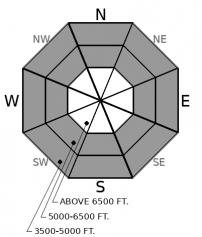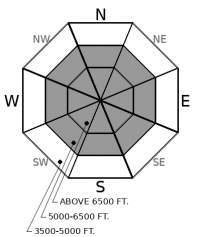| Saturday | Saturday Night | Sunday | |
|---|---|---|---|
| Cloud Cover: | Overcast | Mostly Cloudy | Overcast |
| Temperatures: | 30 to 35 deg. F. | 23 to 28 deg. F. | 25 to 30 deg. F. |
| Wind Direction: | SW | SW | S |
| Wind Speed: | 15 to 25 mph, gusting to 35 mph | 10 to 20 mph, gusting to 30 mph | 5 to 15 mph, gusting to 25 mph |
| Snowfall: | 2 to 4 in. | 0 to 2 in. | 2 to 4 in. |
| Snow Line: | 4000 FT | 3000 FT | 3000 FT |
Flathead Range and Glacier National Park
How to read the forecast
A Special Avalanche Bulletin remains in effect until this evening. Wind and new snow continue to build sensitive drifts in exposed terrain. On sheltered slopes, it is possible to trigger soft storm slabs that lay over weak layers and crusts. Travelling in avalanche terrain today requires careful snowpack evaluation and conservative decision making. Watch for blowing snow on steep open slopes. Shooting cracks are an obvious sign of instability.

3. Considerable
?
Above 6500 ft.
2. Moderate
?
5000-6500 ft.
2. Moderate
?
3500-5000 ft.
- 1. Low
- 2. Moderate
- 3. Considerable
- 4. High
- 5. Extreme
-
Type ?
-
Aspect/Elevation ?

-
Likelihood ?CertainVery LikelyLikelyPossible
 Unlikely
Unlikely -
Size ?HistoricVery LargeLargeSmall

Moderate winds have been transporting the new snow onto leeward aspects in alpine terrain. These drifts could be over a foot thick and sensitive to the weight of a rider. Look for blowing snow or recent drifts in exposed terrain and downwind of ridgetops and crossloaded features. Shooting cracks are directs signs that you have wandered into harms way.
-
Type ?
-
Aspect/Elevation ?

-
Likelihood ?CertainVery LikelyLikelyPossible
 Unlikely
Unlikely -
Size ?HistoricVery LargeLargeSmall

6 to 8” of new snow continues to load weak surface hoar, facets, and crusts. These layers exist at all elevations but are most prevalent and weakest at middle elevations. Storm slabs failing on these layers could propagate farther across the slope than expected. Be extra cautious of areas that received more snow or windloading. Shooting cracks are a red flag.
-
Type ?
-
Aspect/Elevation ?

-
Likelihood ?CertainVery LikelyLikelyPossible
 Unlikely
Unlikely -
Size ?HistoricVery LargeLargeSmall

Thick slabs have broken on deeply buried weak layers with every major storm cycle this winter. The most recent was a number of very destructive slides that broke up to 5 feet deep at upper elevations in the Flathead Range and Glacier Park. These slides have been commonly triggered by cornice falls or small avalanches in the upper snowpack. As new loading continues today, with an expected uptick in avalanche activity, be extra cautious of overhead hazards from alpine start zones. Choose terrain that minimizes your exposure below steep, rocky, variable start zones.
A Special Avalanche Bulletin remains in effect through this evening. Dangerous avalanche conditions exist in parts of the forecast area. In other areas, avalanche danger is heightened at a minimum. Conservative decision making is essential for your safety this weekend.
New snow between 6 and 10” has fallen since Thursday. The Swan Range continues to receive the most new load. As showers continue throughout today, existing slabs with thicken, become more cohesive, and may break in unpredictable ways. Southwesterly winds are expected to increase near the Divide. Fragile layers of surface hoar, facets, and crusts that developed during high pressure last week are now sensitive buried weak layers. New avalanches may fail in surprising ways and be larger than expected under these conditions. Slabs can break above you on the slope. Consider overhead hazards and new loading continues to add weight to deeply buried, old weak layers at the bottom of the snowpark.
A weak disturbance pushes though the area today with a few inches of new snow, light to moderate snowfall, and gusty winds this afternoon over the Divide.
This forecast applies only to backcountry areas outside established ski area boundaries. The forecast describes general avalanche conditions and local variations always occur. This forecast expires at midnight on the posted day unless otherwise noted. The information in this forecast is provided by the USDA Forest Service who is solely responsible for its content.






































